- Home
- Jaylen Florian
Bravado (Unexpected Attraction Book 3) Page 2
Bravado (Unexpected Attraction Book 3) Read online
Page 2
Christine and Patrick understood and accepted the rules. But through the years both had tried to convince Rodney he was doing himself more than harm than good by keeping them an arm's length away on vital developments that would involve them all, in the end.
Their dinners were delivered and Rodney stayed quiet during the remainder of the meal. Christine and Patrick jubilantly discussed their ideas for Rodney's web site and social media accounts in light of the certainty about how much attention was about to descend on him from the press. They discussed new photo shoots, price changes for pieces currently available for sale, and promotion of Rodney's upcoming line of nature-inspired works that he'd announced nearly a year earlier.
When their plates were cleared and coffees ordered, Rodney interrupted their giddy ideas to remind them that complete confidentiality was required, once again, then he dropped his second bomb of the evening.
"We'll have to keep the focus only on the bridge installations and my past sculptures still available for sale at the galleries. I have nothing new I'm prepared to exhibit in any way just yet."
This statement alarmed Patrick the most. He jolted in his seat, and said, "Don't beat around the bush. You've been promising collectors, benefactors, and fans new pieces for too long already. We must tease out at least a partial preview of your new creations."
Rodney, solemn, shook his head.
"Seriously, no?" Patrick asked. "Okay, then, we'll tease out one piece."
"No, we can't do it."
"These people are counting on you."
Rodney exhaled and drooped back in his seat, then admitted, "I'm floundering, guys. The truth is, I haven't even started the new nature line. I've made zero progress. Zero! Even worse, I don't have any finished sketches to work from." Rodney generally prepared a series of detailed concept sketches before he began working with clay, wood, aluminum, steel, bronze, porcelain, and numerous other substances that were unforgiving during the execution stages.
"What in the hell is wrong, Rodney?" Patrick asked him, with some empathy in his voice.
"I don't know."
"Burnout?"
"Maybe," Rodney answered. "Passion for art continues to dominate my life. That's not the issue. But creatively, I've crashed. I'm struggling to take even the first step forward. And I can't bear the thought of going backwards and doing styles I already outgrew in years past, no matter how much I need the income. This is my worst career pause yet, by far. I keep expecting a breakthrough at any moment, yet I'm still waiting . . ."
"What can we do?" Christine asked.
"Thank you for asking that, but there's nothing, really. This is my battle. It's like a personal war I'm having with myself. The two of you are doing what you're supposed to do. I'm the one falling short right now. I have to fight this alone. Just help me buy more time with buyers and galleries, I guess, until I can catch new inspiration."
Christine suggested that the upcoming announcement could be the spark of good news that Rodney needed to restart his creative process. Patrick was skeptical he could hold off Rodney's top collectors for long and reminded him that any hint of stagnation leaking out to the public could affect his relationships with collectors. The three of them reaffirmed their commitment to confidentiality about everything disclosed and discussed at the dinner meeting, then finally concluded with one solid plan.
Rather than hold one-on-one media interviews after the city's announcement honor, they'd appear to cobble together a last minute press conference so Rodney could address all of the reporters at once. Rodney agreed to this and Patrick said he would arrange for some planted questions.
Chapter 3
The governor wasn't the only special guest attending the city's big announcement.
As if on cue, a morning haze lifted from Bigbury Plaza—a five-block rectangular expanse of walkways, greenery and flower gardens—that paralleled the Bluestone River south of downtown Doyle. Buttery sunlight reflected off the river's gentle ripples onto the stone facades of the arched bridges that linked downtown to the Quilley District, which was a slender islet containing a history museum, bistros, an outdoor pavilion, and tree-lined streets clustered with late 19th century-inspired shops and boutiques. The original purpose of the three bridges, separated less than a hundred yards apart, was for Doyle merchants to transport and receive goods ferried to the islet by steamships.
The Bluestone River split in two channels around the islet. Most boats, whether commercial or private, were required to use the river's large northern channel, along with jet skis and sailboats. The much smaller channel to the south of the Quilley District, which flowed under the arched bridges, was limited to canoes, kayaks, and rafts. The city honored its heritage by maintaining a family-friendly, clean, and well-maintained sector that extended from the islet of the Quilley District south to Bigbury Plaza and Doyle's downtown square.
Marshall Clay and the numerous other assembled members of the press were positioned in Bigbury Plaza on an elevated platform that was equal to the height of the event stage so that their camera angles captured a scenic view of the Quilley District in the center of the river. Local attendance had swamped expectations, overflowing the rows of arranged metal chairs into standing-room only zones on both sides of the stage. Behind the podium was a crescent-shaped line of chairs for dignitaries, including both of the state's United States senators, the region's congresswoman, two state representatives, the president of Niven University, two retired professional sports stars, and the CEOs of the major companies sponsoring the upcoming national kayak races. By the time the mayor of Doyle, Dimitri Ustinov, thanked the governor and all of the special guests, who each rose to the microphone to add their remarks, an hour had passed. Marshall felt as restless as the gathered spectators, cursing to himself about how these events tended toward insufferable pomposity.
Marshall was, however, still very alert. He'd learned the evening before, from a press advance kit distributed by the mayor's office, the identity of the three Doyle artists competing for the bridge sculpture installations.
Sorting through the artists' pictures and bios, one of them had been recognizable to Marshall. He'd felt an immediate zap upon seeing Rodney Riggs Redfern, identifying him as none other than the stranger he'd encountered on the train. Redfern had been photographed shirtless before a black screen, looking at the viewer with his head tilted downward and to the side, his arms raised. The angle of his face highlighted that smoldering gaze, furtive and breathless. He had a heavy brow, ridged nose, and strong jawline and chin covered by a dense and meticulously groomed beard.
In contrast, the other two artists selected as finalists—a woman named Flora Miles and a man identified as Kenneth Blakely—had profile pictures revealing smiling faces and colorful attire. Miles had been photographed in a kaftan in her art gallery and Blakely had worn a bowler hat in a traditional portrait taken against a brick wall.
Marshall imagined that Redfern couldn't hardly water down his provocative image so he'd fully embraced it, even for materials displayed at a joint government and business function.
So Marshall was intrigued by the man yet again. Not, this time, for prurient reasons. Instead, he was curious about how Redfern didn't fit the stereotypical image or persona of a fine artist. Even apart from what Marshall had seen of him on the train, Redfern's profile photograph suggested the aura of a professional football player or weightlifter for a seductive magazine spread. He was like the trumped up Hollywood version of an artist, unlike the introverted and introspective artists that Marshall was so familiar with through all of his educational and professional years involved in the fine arts.
As Mayor Ustinov finally concluded the introductions and acknowledgements, the attendees applauded and cheered the introduction of the three finalists. They emerged from behind the stage and stood before the mayor, who launched into glorifying their credentials after another brief word about the city's pride in its up-and-coming hometown artists. The mayor began with Flora Miles and then sp
oke about Kenneth Blakely. They were fidgety and nervous, Marshall thought, with Flora being rather dull and frumpy, and Kenneth looking pessimistic and severe. Redfern, however, stood with assurance. His feet were wide apart, his chin was up, his hands were behind his back, his sleek black slacks and button-down shirt possessed not a single wrinkle, and a faint lopsided grin seemed to express more humility than vanity.
Forget pilot or lumberjack, Marshall thought, this guy is giving off Marlboro Man vibes. He'd look at ease anywhere, under a cowboy hat or attending an opera. Pretending he doesn't have a care in the world. Pretending like nothing could rile him up.
Marshall became convinced that Redfern would be the artist chosen for the honor. This was confirmed moments later when Mayor Ustinov dispensed with the figurative drum roll and outright declared Redfern the winner.
"Flora Miles and Kenneth Blakely deserve our utmost respect and admiration," the mayor said, "and there is no doubt whatsoever that both have stellar careers ahead of them in the arts. Nonetheless, our choice today, after extensive reflection and study and input, is to award Rodney Riggs Redfern the commission for the sculptural installations, which will enhance Doyle's historic bridges in time for the national kayak races at the end of summer."
Marshall watched as at least half the audience leapt to their feet and reacted to the mayor's announcement with a standing ovation. Redfern, Miles, and Blakely all shook hands, then Redfern waved to the audience and received an inspired heightening of cheers.
The mayor gestured for the spectators to let him continue, and said, "Redfern is one of our own. He was born and raised in Doyle, graduated from Palma High School, and studied art history here at Niven University before transferring to the prestigious Poirot Academy of Fine Arts in London. After apprenticeships with internationally renowned visual artists in Quebec City, Canada, and Oahu, Hawaii, Rodney returned to Doyle. His parents—Ralston and Gina Flynn—were longtime residents of Doyle before retiring last year to Florida."
Curiously, the mayor didn't address that Redfern had changed his given surname. But Marshall was not surprised that grandstanding politicians on stage were shaking Redfern's hand and congratulating him personally rather than listening attentively to the mayor's speech. Such gestures were power plays in and of themselves, and politicians feasted on such sleights of hand.
"Rodney's unique sculptural perspectives have developed beautifully since his return home," Mayor Ustinov said, full of pride. "His works are dynamic and convey movement. Unlike static sculptures where the impetus is on the viewer to discover new angles and viewpoints, Redfern's pieces are always changing and challenging us. One of the most reputable art journals in North America tried to summarize his style as raw, earthy, and primal. Others have praised his graceful lines and textures. I spoke this morning with one of Rodney's former professors at the university who described his art as an aesthetic blend of physics, combat, and gravity. Our decision for him today was essentially unanimous. Rodney's sculptures will not diminish or permanently alter the character of Doyle's historic treasures—our bridges over a portion of the Bluestone River. Instead, they will complement them, in appropriate alignment, with the national kayak races showcasing our wondrous city to the world. Rodney's installations will be featured on the parapets of the Devon Bridge, the Mason Bridge, and the Sylvia Bridge. We now invite you to our magnificent courthouse"—the mayor pointed at a massive Romanesque Revival brownstone structure with a clock tower positioned at the eastern edge of the plaza—"for a display about Rodney Riggs Redfern's sculptures, as well as a gallery documenting the history of Doyle's three enchanting bridges."
When the announcement ceremony ended, most of the audience headed toward the courthouse. But a very well-dressed man in a tailored suit bounded onto the stage, using a cane to agilely maneuver up the steps, and whispered into the mayor's ear. Mayor Ustinov moved his head up and down a few times as he listened and then returned to the microphone at the podium.
"Excuse me, everyone. I have a final word to add. I just learned that Rodney arrived in town late last night, coming all the way from Paris, where he participated in a prestigious French exhibition. So instead of being immediately available for the media at the courthouse gallery, Rodney will have a press event at one o'clock at Niven University's Emily Odell Hall."
Marshall Clay didn't want to wait on having his questions addressed. The answers could very well steer the direction of his story. He descended the media station platform and hustled toward the stage. But the man with the cane ushered Redfern away to the back of the stage. Marshall looked for Redfern behind the stage curtain. The artist had vanished. Marshall spoke briefly with the other two finalists and also took quotes from the governor before strolling toward the courthouse.
Recalling the unusual press notification at the end of the ceremony, Marshall was equally amused and perplexed.
What was all this about France?
What did supposedly arriving from Paris have to do with the timing of Redfern's availability for the press?
Chapter 4
Rodney took some comfort remembering the magic rule when dealing with the media.
He was accustomed to interviews in various formats. But his media event at the university's Emily Odell Hall, on the heels of the announcement of his selection by the city, was his first to be structured like a press conference. Rodney had agreed to his manager's event plans on two conditions. First, there would be no podium. He would be seated at a banquet table with a microphone, as if having a conversation, not giving a speech. Rodney was accustomed to seeing this type of press availability on ESPN after professional sports games and believed it usually provided a non-confrontational atmosphere. Second, the reporters would have the option of being seated at tables, too, positioned close enough to him that he wouldn't have to raise his voice.
Rodney didn't expect a confrontational atmosphere. Patrick Castle, his manager, had prepared him with a list of the most likely questions, along with recommended answers. The questions Patrick would have planted, perhaps with the student reporters or his longtime contacts in the media, would be easy-breezy softballs. On the other hand, Rodney's experience was that journalists were intelligent and unpredictable.
He'd do his best to keep his answers tight and focused. He'd fess up to not knowing the answers if questions were out of his bounds, instead of making up an answer. He wouldn't engage in any speculation or hypotheticals.
Tone and presence is all important. That was Rodney's magic rule with the media. The saving grace.
The tone and tenor of his demeanor—his posture, voice, temperament, humility—would outweigh the importance of his specific answers. In other words, being genial and relaxed and modest from the outset would keep him on track and carry the day.
His manager had brilliantly selected Emily Odell Hall's student workshop for the press event. It harkened back to Rodney's roots at the university and his status as a locally-based artist. In contrast to a cold and sterile banquet room at the courthouse, this put the press amidst the art stations which lined the walls and corners of the room, including everything from supplies for ceramics to acrylics and printing and watercolors. The workshop had a pleasant aroma—somewhere between fresh paint and fresh newsprint—and muted sun rays from overhead skylights illuminated the tables with a soft glow, which would be ideal for the news cameras.
Christine Blatt, Rodney's assistant, had also contributed a wonderful idea. Rather than having Rodney strut into the room at one o'clock for the cameras, he would arrive fifteen minutes early and personally welcome the reporters and photographers in the hallway, just outside the door. Christine understood that Rodney would be at his best the more he was natural and at ease. She also knew that his physical presence—standing before them, one on one—would be impressive. It would heighten his stature as an artist.
Dressed in the same spiffy clothes from the morning announcement, Rodney arrived in the hall and discovered an easy rapport with the reporters, greeting
them with gratitude for their attendance. A few of them he'd met before and they were especially congratulatory to him about being selected for the honor.
Marshall Clay, walking in at the last minute, was the final reporter approaching the room. He had on pleated slacks, a sports coat, and a crisp white button down shirt. Marshall carried nothing in his hands and maintained a blank expression as he stood before Rodney and gave him a steely handshake.
Rodney needed only a second to realize the man before him was the same man he'd wanted to meet on the train from Port Cole. The tall and confident guy with dark, wolf-like features and a five o'clock shadow. Then, as now, this man's probing stares reminded Rodney of the type of guy you'd expect to play a gangster in a crime movie or a jaded cop in a gritty police drama.
"And here you are, the guy who disappeared on the train," Rodney said, brightening with a cheerful smile. "We never know what fate has in store for us, huh?"
Marshall, however, did not acknowledge any familiarity with him. Marshall ignored Rodney's comment and moved on to another topic.
"My research has yielded some specific points I need clarification on, Mr. Redfern." The reporter's mood was dry, and almost ominous.
"Do you have a business card?" Rodney asked.
Marshall handed him a plain white card from a front pocket of his sports coat. At top center, on three lines, was: Marshall Clay, journalist, The Port Cole Pioneer. The bottom portion listed a direct phone line, main news agency number, email address, and web address for the newspaper. It was a simple, no-frills card. Rodney flipped it over. The back was completely bare. Looking again at Marshall, who now seemed even colder and more remote, Rodney began having a tinge of doubt that this was the same man from the train.

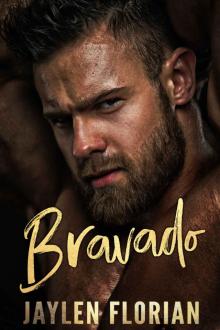 Bravado (Unexpected Attraction Book 3)
Bravado (Unexpected Attraction Book 3)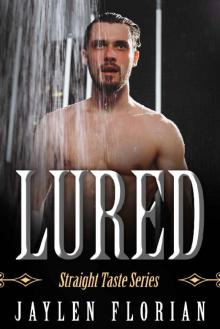 Lured (Straight Taste Book 3)
Lured (Straight Taste Book 3)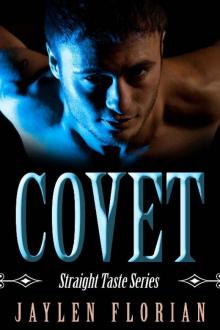 Covet (Straight Taste Book 4)
Covet (Straight Taste Book 4)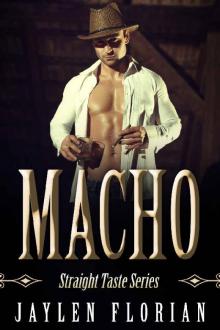 Macho
Macho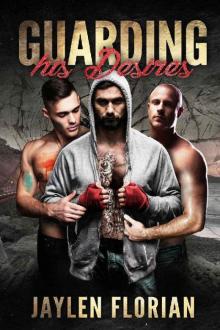 Guarding His Desires (Passionate Security Book 2)
Guarding His Desires (Passionate Security Book 2) Untame (Straight Taste Book 5)
Untame (Straight Taste Book 5)